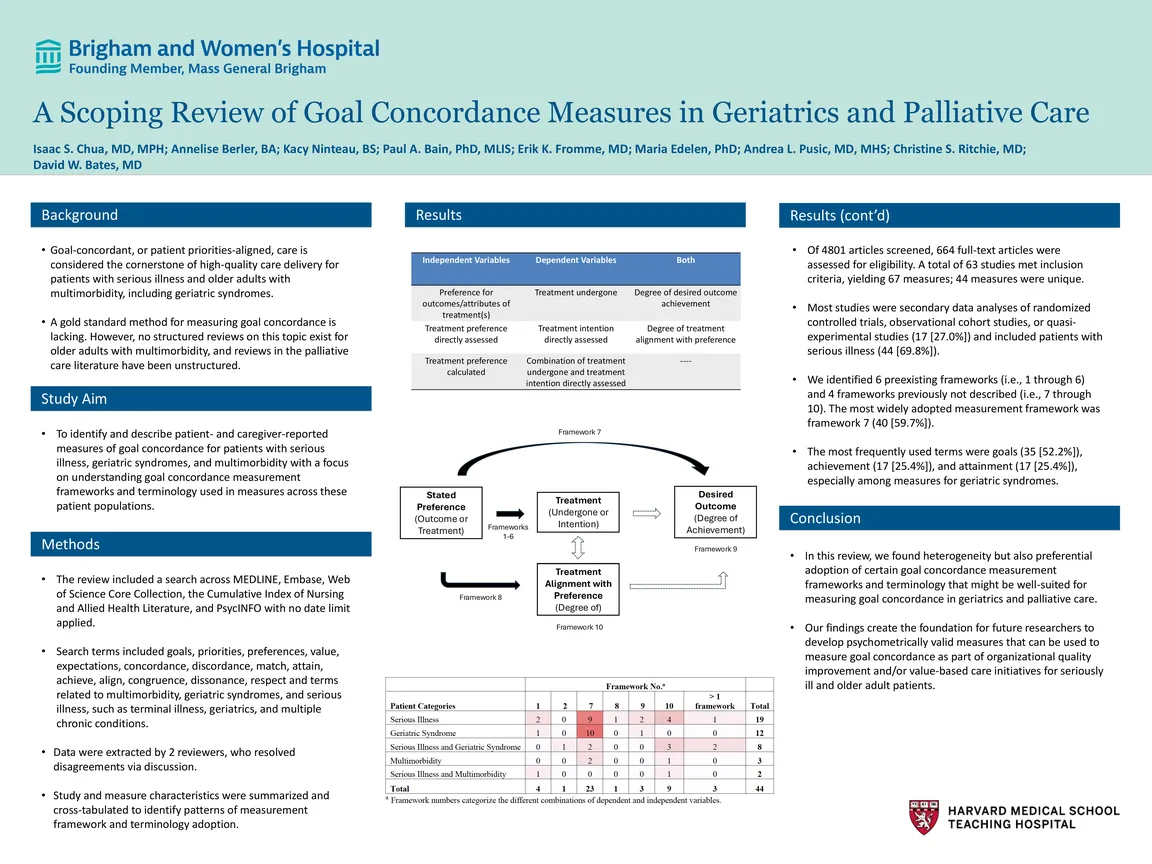A Scoping Review of Goal Concordance Measures in Geriatrics and Palliative Care
Goal-concordant care, also known as priority-aligned care, is a cornerstone of high-quality care delivery for patients with serious illness and older adults with multimorbidity. However, there is currently no gold standard method for measuring goal concordance. This project aimed to identify and describe patient- and caregiver-reported measures of goal concordance for populations with serious illness, geriatric syndromes, and multimorbidity. The focus was on understanding the frameworks and terminology used to measure goal concordance across these patient populations.
The review included a search across MEDLINE, Embase, Web of Science Core Collection, the Cumulative Index of Nursing and Allied Health Literature, and PsycINFO with no date limit applied. Search terms included: goals, priorities, preferences, value, expectations, concordance, discordance, match, attain, achieve, align, congruence, dissonance, respect and terms related to multimorbidity, geriatric syndromes, and serious illness, such as terminal illness, geriatrics, and multiple chronic conditions. The review included original research in accordance with PRISMA guidelines. Data were extracted by two reviewers, who resolved disagreements via discussion. Study and measure characteristics were summarized and cross-tabulated to identify patterns of measurement framework and terminology adoption.
Of 4801 articles screened, 664 full-text articles were assessed for eligibility. A total of 63 studies met inclusion criteria, yielding 67 measures; 44 measures were unique. Most studies were secondary data analyses of randomized controlled trials, observational cohort studies, or quasi-experimental studies (17 [27.0%]) and included patients with serious illness (44 [69.8%]). We identified 6 preexisting frameworks, and 4 frameworks previously not described. The most widely adopted measurement framework (i.e., Model 7) paired patient preference for outcomes/attributes of treatments with degree of outcome achievement (40 [59.7%]). The most frequently used terms were goals (35 [52.2%]), achievement (17 [25.4%]), and attainment (17 [25.4%]), especially among measures for geriatric syndromes.
This scoping review codifies and highlights commonly adopted measurement frameworks and terminology adoption among patient- and caregiver-reported measures of goal concordance for patients with serious illness, geriatric syndromes, and multimorbidity. In this review, we found heterogeneity but also preferential adoption of certain goal concordance measurement frameworks and terminology that might be well-suited for measuring goal concordance in geriatrics and palliative care. These findings lay the foundation for future researchers to develop psychometrically valid measures that can be used to measure goal concordant, or priority-aligned, care as part of organizational quality improvement and/or value-based care initiatives for seriously ill and older adult populations.
Authors
- Isaac Chua, MD, MPH (Brigham and Women's Hospital)
- Christine Ritchie MD, MPH (Massachusetts General Hospital)
- Annelise Berler, BA (New England Institute of Clinical Research)
- Kacy Ninteau, BS (University of Massachusetts Chan Medical School)
- David Bates, MD (Brigham and Women's Hospital)
- Maria Edelen, PhD (Brigham and Women's Hospital)
- Paul Bain, PhD (Harvard Medical School)
- Erik Fromme, MD (Dana-Farber Cancer Institute)
- Andrea Pusic, MD, MHS (Brigham and Women's Hospital)
